Apple iPhone 6 Plus vs Samsung Galaxy Note 3
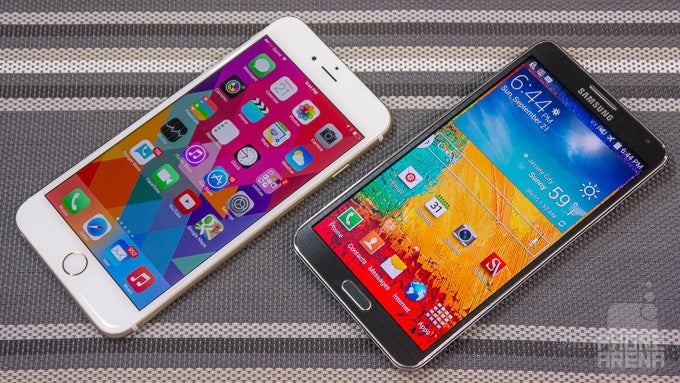
Introduction
Apple's acknowledgment of the big-screen phones trend resulted in the 5.5” iPhone 6 Plus. It's just inevitable that Apple's first foray in the 5”+ range will get compared to the Samsung line that started it all, that's why we are pitting the iPhone 6 Plus against the Galaxy Note 3. Samsung's phablet sports a tad larger display, but similar dimensions.. Which one is for you? Let's see...
Design
Tall, slim and handsome – that's the iPhone 6 Plus next to the Note 3, yet it's even more unwieldy to carry around, akin to its newfangled phablet status.
The iPhone 6 Plus is a plus-sized phablet indeed. It is way taller than the Note 3, which is already uncomfortable to carry around in a pocket, but is slimmer and less wide, so one-handed operation is a tad easier on Apple's biggie. Apple had to fit the inevitable Touch ID sensor underneath the display. That same fingerprint scanner comes rather uncomfortable to use on such a large device with one hand, as you have to stretch your thumb pretty hard each time you want to hit on the home key, or initiate an Apple Pay authorization, for instance. Not that the Note 3's home key placement is any better, though. As a whole, we wouldn't recommend you to use any of these two huge phones with one palm – these big phablets are designed for usage with both of your hands.
When it comes to the looks and build, the 6 Plus has the upper hand, as it sports a very slim, 7.1mm profile, and premium aluminum unibody that feels very light and classy in the palm. Samsung compensates the relatively thick and plastic-y design with more flexibility, such as the option to swap the battery at will, or expand storage with the supplied microSD slot. It also offers a stylus, called the S Pen, tucked neatly in the silo at the lower right, as an additional input method for those keen on doodling, handwriting, or precision-clipping on their phablet's display.
Display
Apple's signature bright color-accurate panels make their way into its first phablet, too, whose screen tops the Note 3 on most all counts that matter.
Both Apple and Samsung went with 1080x1920 pixels of resolution, which is the typical option for most flagships out there. Due to the Note 3 having a tad larger screen size – 5.7”, against Apple's 5.5-incher, it flaunts 386ppi density, while the 6 Plus crosses into the 401ppi count. Both pixel densities are up to snuff, though, and you won't notice any jaggies or pixelization from a normal viewing distance.
The color representation round goes to the iPhone 6 Plus. It has more accurate colors and color temperature, while the Note 3 display is colder and colors are largely inaccurate, exhibting very saturated, even gaudy colors in all screen modes it has.
The Note 3 screen also sports a pretty low peak brightness, which makes it harder to tell outdoors, compared to the luminant iPhone 6 Plus display. Samsung's panel does sport a pretty good anti-reflective coating, which minimizes the light sent back to your eyes, and still Apple's phone looks noticeably more legible in bright sunlight.
Interface and functionality
Flanked by its S Pen sidekick, Note 3 is a multitasking powerhouse, while Apple's first foray into the phablet category wisely includes a landscape interface mode, unlike TouchWiz.
We won't be extolling the virtues of one mobile operating system before the other here, as you can refer to our thorough Android vs iOS comparison for that. Being the large phones that they are, however, it's important that the iPhone 6 Plus and the Note 3 have one-handed interface modes. Apple's one is called Reachability, but the phone also provides a landscape viewing regime for the whole interface, a feature that is sorely lacking in Samsung's TouchWiz Android overlay. The Note 3's one-handed mode is way easier to evoke, though, as it requires simply a quick swipe back and forth at the edge of the screen with your thumb, while you have to stretch all the way beneath the display on the 6 Plus, and then double-tap on the home key. You get used to doing it quick, but it's just not very comfortable. Moreover, what Reachability does, is simply slide down the interface, so you can reach whatever you couldn't grab before at the top of the display, while Samsung's approach shrinks the whole interface left or right, as if you are using a handset with a much smaller screen.
Samsung allows you to split the screen in two with its Multi-Window mode, and run any two apps simultaneously, for a true multitasking experience. You can also hover up to five windowed apps, like a calculator, browser, or notes, on top of whatever runs underneath, and resize or move them around at will. These take the Note 3 more into the productive device category, than the merely big-screen-for-media-consumption league that most phablets are in, including the 6 Plus. The Galaxy Note 3 also sports an extra input method, thanks to the embedded S Pen stylus, and the interface options to match. You can clip content from websites with it, annotate PDFs, doodle and handwrite on the display, or simply use it to scroll or hover over links for added convenience.
Processor and memory
Helped by its new A8 chipset, Apple propels the iPhone 6 Plus performance past last year's Note 3.
Apple uses a new (again 64-bit, of course) 1.4 GHz dual-core A8 CPU with Cyclone cores, built on the frugal 20nm process, with souped-up hexa-core PowerVR GX6650 graphics. It is both faster and more efficient than the A7 in iPhone 5s or iPad Air, and cross-platform benchmarks indicate it to be roughly in the realm of Snapdragon 805 on a per-clock basis, meaning that if it was running at the 2.5 GHz speeds of the 805, it would have similar performance. The LTE version of the Note 3 is powered by last year's Qualcomm finest - a 2.3 GHz quad-core Snapdragon 800, clocked at 2.3 GHz. There is also a global variant with Samsung's Exynos 5 Octa CPU, which combines four 1.9 GHz ARM Cortex-A15 cores with four 1.3 GHz ARM Cortex-A7 ones.
An advantage Note 3's silicon has before the iPhone 6 Plus are its 3 GB of RAM, against the one gig on Apple's phablet, and you'll need every bit of that random-access memory when you take advantage of the split-screen multitasking action. When it comes to storage options, the iPhone 6 Plus comes in a wide range of configurations, from the 16 GB starter, all the way to an expensive 128 GB version, while the Note 3 ships with 16 GB, and offers you a microSD slot for adding up to 128 GB more, if you are so inclined.
Internet and connectivity
Browsing on these two is a joy for the senses, but when it comes to delivering those data speeds, the 6 Plus holds the record LTE bands count.
Using Apple's stock Safari browser on the large display of the 6 Plus is a joy for the senses – it is snappy, fluid, and renders pages very well. Text reflow is also flawless, but the scrolling inertia is still a chore in iOS 8 as it has ever been, meaning non-existent, which somewhat hinders the experience, especially when you compare it with Android's dynamic scrolling that can take you to the end of a page and back up in no time, based on the speed of your finger-flick. Browsing on the Note 3 is also seamless, though the stock TouchWiz browser looks less polished than Safari, with its squarish interface elements. It is very fast, though, and functional, too, offering you the ability to display Adobe Flash content, if you sideload the APK file from Adobe's website. The S Pen stylus of the Note 3 offers you a way to easily select text, pictures, and cut sections of a website for sharing or inserting in a note, too.
The iPhone 6 Plus is the undisputed king when it comes to 4G LTE connectivity, as it offers anywhere from 16-20 LTE bands, depending on the model, which means that you can use it almost anywhere in the world. The Note 3 also has a 4G LTE version (the Snapdragon one) – it doesn't support as many bands as the 6 Plus, so pay attention to the carrier you want to be using it on. Both phablets have an LTE Cat. 4 modems, with theoretical download speeds reaching 150 Mbps maximums, though in real life it will be much less, of course. The phones support almost all other wireless connectivity options you can think of - Wi-Fi/ac, Bluetooth, A-GPS, DLNA and NFC, with the Note 3 adding Wi-Fi Direct and an infrared sensor for controlling home electronics. You can use the iPhone's NFC for Apple Pay – Cupertino's own mobile payment network, which has already signed up some of the largest retailers, and authorize purchases with the Touch ID finger scanner.
As for wired connectivity, the iPhone 6 Plus depends on Apple's proprietary Lightning connector, which requires an adapter to plug it into an HDMI port for TV-out purposes. Note 3 has a proprietary MHL connector in its turn, which can either be plugged directly, if your TV has an MHL port, or via an HDMI adapter.
Camera
The Note 3 camera is no slouch, yet the optically-stabilized unit of the 6 Plus dishes out better low-light shots, and steadier video.
The camera on the iPhone 6 Plus is an 8 MP one, while the Note 3 flaunts a 13 MP sensor. However, the iPhone sports larger, 1.5 micron pixels, compared to the 1.1 micron size of Samsung's unit. The 6 Plus also dabbles in the so-called phase detection auto-focus (or Pixel Focus, as Apple calls it). It is a feature borrowed from high-class cameras allowing the camera to focus even faster on its subject. Another great extra Apple placed in its first phablet, is the optical image stabilization system for keeping the frame steady, reducing handshake. Apple again uses a TrueTone LED flash, which balances out colors, making them look more natural, and the Note 3 issues similar claims for its high CRI (Color Rendering Index) LED flash. The frontal cameras are 2.1 MP, in the case of Note 3, and a 1.2 MP unit on the 6 Plus.
Opening the camera app and taking pictures is instantaneous with the iPhone 6, with no tangible lag between photos. The Samsung Galaxy Note 3 camera app loads quickly and exhibits little to no shutter lag, which is great for capturing events as they happen. The camera UI of the Note 3 is way more cluttered with functions you may or may not use than the clean, easy iPhone 6 Plus snapping interface. Both phones offer Panorama and Burst modes, as well as HDR for pictures and video, but Samsung adds plenty of shooting modes and color effects to the roster, while the iPhone keeps it simple, leaving those to 3rd party apps.
Both phones take fine looking photos, that aren't gaudy or saturated. The iPhone 6 Plus white balance measurements often nudge the scene towards a slightly warm overcast, while the Note 3 photos are slightly colder than in real life, but these are just minor inaccuraties. The phablets capture a good amount of detail in good lightning conditions, but the Note 3 13-megapixel pics are slightly more detailed than the 8mp ones of the 6 Plus. Where the iPhone excels, however, are the tricky low-light scenarios. Most every phone takes decent pics when there is plenty of light shining on the scene, but the larger pixels of the iPhone 6 Plus, coupled with the OIS and Apple's excellent camera software, make for very clear, well-defined and sharp indoor shots, with credible color representation, and less noise than what the Note 3 musters. Apple's TrueTone LED flash also does a better job at illuminating our test scene, with stronger and more evenly distributed light output.
In terms of video, Apple continues supporting 1080p only, so there is no 4K utlra high-resolution video, which the Note 3 can capture. Both handset are capable of 1080p recording with extra smooth 60fps, too. An upgraded slo-mo mode allows the 6 Plus to capture at twice the frame-rate for a twice more pronounced effect: 720p at 240fps, while the Note 3 does it up to 120fps.
The iPhone 6 Plus records some amazing looking 1080p videos that are filled with plenty of sharp details, lively (if somewhat warmer) colors, and smooth exposure adjustment. The optical image stabilization kicks in each time your hand trembles, for some steady-looking, free-flowing footage. The new iPhone now comes with excellent continuous autofocus, too, which shuttles quickly and seamlessly between close-ups and the background. The recorded audio is also clean and vibrant sounding, thanks to the quality noise-canceling mic set.
Hardly a surprise, the Note 3 is also great with its video recording quality. Just as long as there’s sufficient lighting around, the Note 3’s videos come to life with its smooth recording, sharp details, accurate color reproduction, and clear audio recording. What’s not to like, right? Well, its quality naturally hits a speed bump with lower lighting, but it’s still pretty good looking in our opinion. Out of everything, noise becomes more apparent under this particular circumstance, and it's details that tend to be affected the most – a trap that the 6 Plus manages to avoid.
Multimedia
The iPhone 6 Plus is made for media consumption, but Note 3 supports a wider variety of formats, in addition to the large display.
The stock iOS 8 gallery offers grid-style thumbnail view of your photos, and editing options that are built into the interface, just as Samsung does. Of course, the S Pen stylus offers options for more precise clipping, editing, and annotating photos, if you venture to do those on your phone's screen.
The iOS 8 stock music player is pretty, with minimalistic interface, and song categorization by artists, albums, playlists, genres and so on, as well as album arts support. The sound equalizers are still located in the general iPhone settings menu, though, whereas the Note 3 has them embedded in its aging TouchWiz music player.
Video playback looks gorgeous on both phones, on account of the large, high-res display, though the stock iOS 8 player file format support is very limited, compared to the Note 3, which plays everything thrown at it, including DivX/Xvid/MKV files, at up to 1080p resolution, and with plenty of extras like subtitle support, or floating the player on top of the interface.
Call quality
Good microphones and average earpiece sound marks the call quality course of the two phablets.
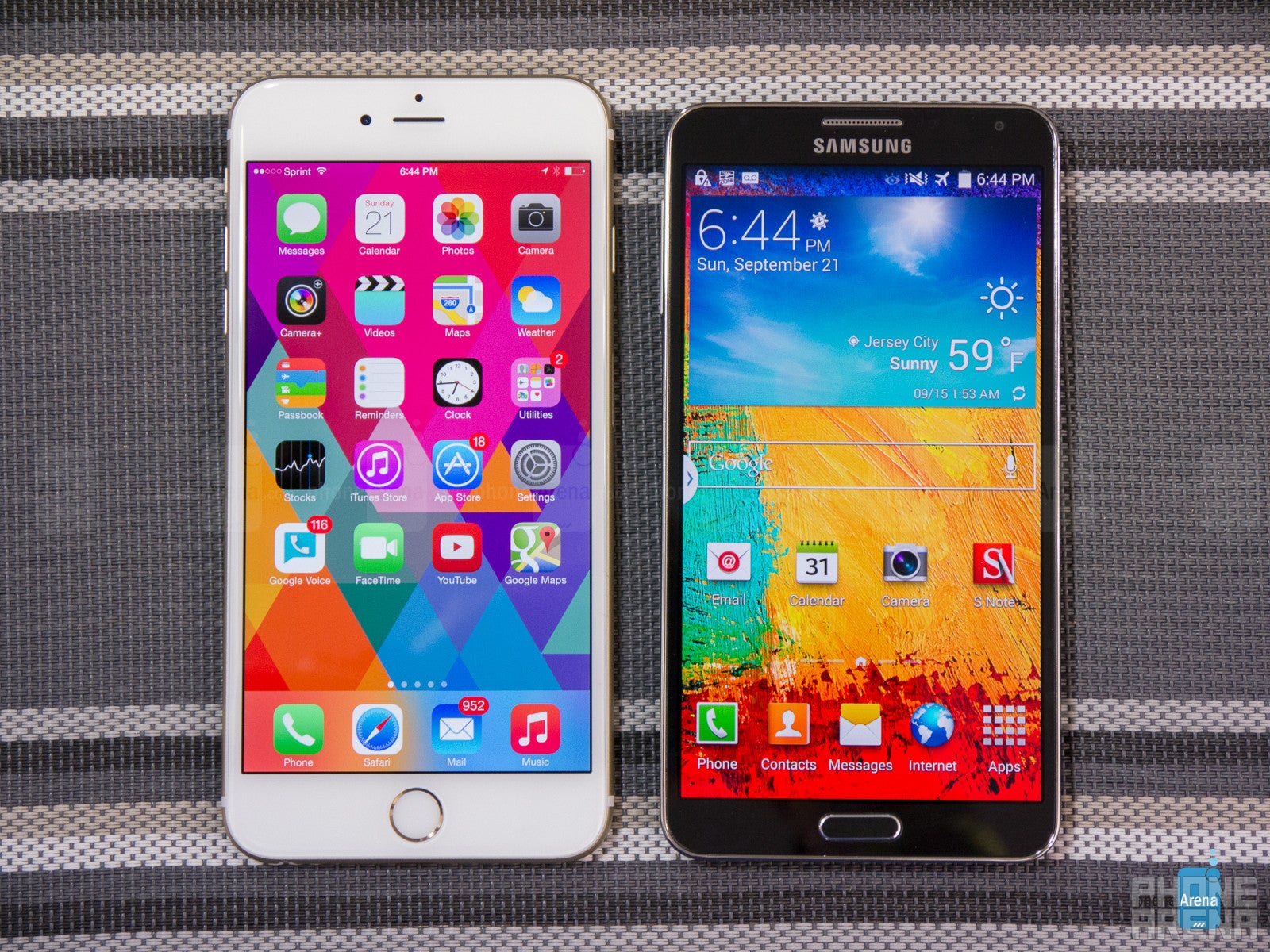
Note 3 is not the best sounding phone we’ve used for phone calls, but nonetheless, it's effective enough for the occasion. Through the earpiece, voices pop with authority thanks to its strong volume – though, there’s a hint of crackling when it’s placed at the loudest setting. It’s noticeable, but quickly remedied by lowering the volume a couple of notches. Still, voices through the earpiece sound very natural in tone. However, we can’t say the same on the other end of the line, as voices tend to sound robotic. Switching to the speakerphone, we’re neither impressed or disappointed, as it works enough to get us through our conversations.
Battery
With their unremarkable endurance, both Note 3 and iPhone 6 Plus will make you reach for the charger at the end of the day.
Apple doesn't cite the exact battery capacity of its iPhone 6 Plus, though dismantling efforts peg it at 2915 mAh, which is in the phablet category ballpark. Apple cites 12 hours of browsing on Wi-Fi, and 14 hours of video-watching on a charge, which are excellent numbers. On our demanding battery benchmark, however, it scored six hours and a half, or close to what the Note 3 musters. Of course, your mileage will vary, depending on the workload and the screen brightness, but overall the 6 Plus should get you through one full day on a charge with normal usage, and even further with light one.
Note 3's huge 3200 mAh battery might have delivered impressive battery life last year, but this year most flagships and midrangers made huge strides in that regard, pushing the Note 3 down the endurance ladder, about equating it with Apple's phablet. Samsung cites 21 hours of talk time on a charge, and 22 days on standby.
Conclusion
The iPhone 6 Plus is Apple's first foray into the phablet borderland, and it impresses on most counts. It brings everything you can expect from an iPhone in a much larger package – the build is as premium as ever, and the screen is bright and very accurate. In contrast, the Note 3 has a not-so-impressive plastic body, but it has replaceable battery and microSD slot. Note 3's AMOLED screen is not color-accurate, though many love the oversaturated hues it produces.
The iPhone 6 Plus comes with excellent camera, which excels in low-light and video capture, thanks to its large pixels and optical image stabilization. Apple's phone also supports a record number of LTE bands, for a truly globetrotting experience.
Note 3 isn't too shabby either – its camera is also great, and it has some software and alternative input aces up its sleeve like split-screen multitasking, or the embedded S-Pen stylus.
For a few years now, Samsung dominated the phablet segment that it created. However, after seeing rivals pop up from most other companies, Apple is now also joining this game, and its model is on par with the best.

Follow us on Google News
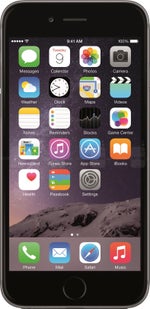
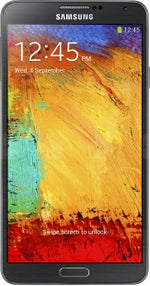














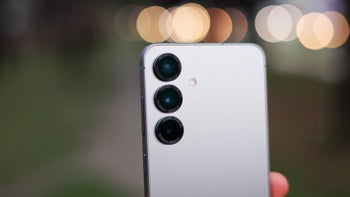



Things that are NOT allowed:
To help keep our community safe and free from spam, we apply temporary limits to newly created accounts: